Watching our loved ones age can stir up many feelings. Their stories from youth mix with quiet days, facing aging’s challenges. For those over 80, staying active is more than health; it’s about feeling alive and free. The elderly need our help to stay active and enjoy life, not just watch it pass by.
We can help seniors move more, improving their health and happiness. This article will share important tips to boost physical activity in older adults. We’ll show how to encourage them to get up and explore the world around them.
Key Takeaways
- Physical activity is vital for elderly individuals, enhancing health and mobility.
- The CDC recommends 150 minutes of moderate activity weekly for those aged 65 and older.
- Incorporating strength and balance exercises can significantly reduce fall risks.
- Regular engagement in physical activity supports cognitive function and improves quality of life.
- Encouraging gradual physical activity increases can make a substantial difference for seniors.
The Importance of Physical Activity for the Elderly
Regular physical activity is key for older adults, boosting their health and happiness. They face a higher risk of heart disease and stroke. So, moving more is crucial. Aiming for 150 minutes of activity each week can greatly improve their health. This can be done through simple tasks like self-care and household chores.
Many seniors struggle to stay active, with 21.4% globally inactive. Lack of activity increases the risk of chronic diseases and can harm mental health. But, regular exercise can improve mood and even slow dementia.
Exercise helps older adults avoid falls by 21%. It also lowers injury rates and improves life quality. Yet, many face challenges like finding time or dealing with health issues. Support and supervision are vital for consistent exercise.
Physical activity offers more than just physical benefits. It also boosts mental and social health. Creating a community for active living is essential. It helps build stronger connections and better health.
Understanding Physical Activity Guidelines for Older Adults
Physical activity is key for older adults. It greatly affects their health, how long they live, and their quality of life. The guidelines suggest that older adults should do aerobic activities and muscle-strengthening exercises. This helps them stay mobile, lowers the risk of chronic diseases, and delays age-related health problems.
Recommended Intensity Levels for Aerobic Activities
Older adults should do at least 150 minutes of moderate-intensity aerobic activities each week. This can be split into 30-minute sessions on five different days. For those who prefer more intense workouts, 75 minutes of vigorous-intensity aerobics spread over three days is recommended. Doing more than the minimum can improve fitness and health benefits.
Guidelines for Muscle-Strengthening Activities
It’s important for older adults to include muscle-strengthening exercises in their routine. They should do these exercises at least twice weekly, focusing on major muscle groups. This boosts strength and helps prevent falls by improving balance. Activities to improve flexibility should be done at least two days a week, lasting about 10 minutes each.
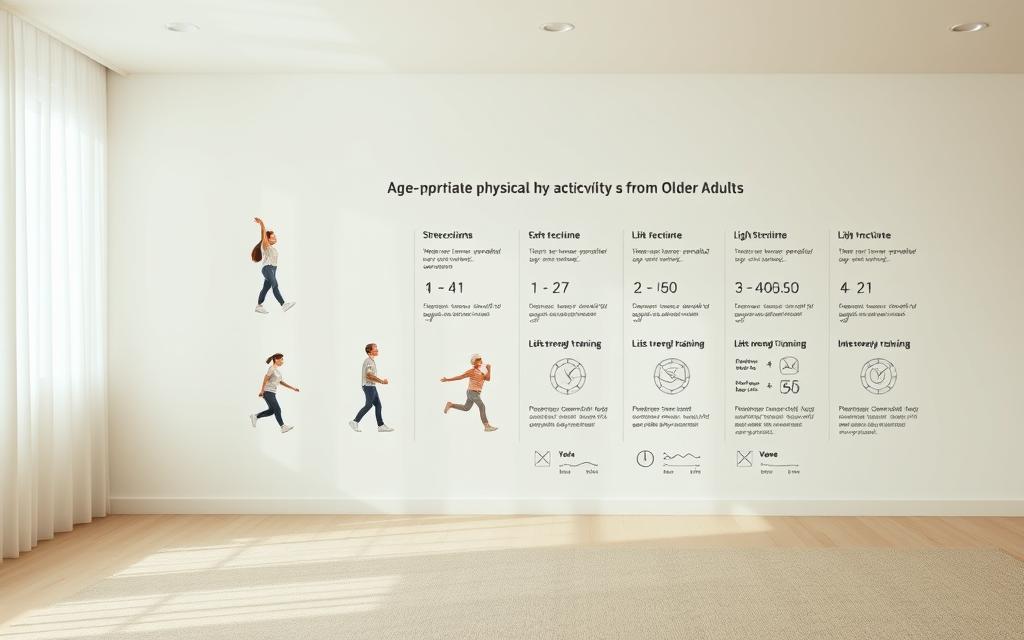
| Type of Activity | Moderate Intensity | Vigorous Intensity | Frequency |
|---|---|---|---|
| Aerobic Activities | 150 minutes/week | 75 minutes/week | 5 days/week (30 min) or 3 days/week (20 min) |
| Muscle-Strengthening Exercises | Essential | Essential | At least 2 days/week |
| Flexibility Activities | Essential | Essential | At least 2 days/week (10 min) |
As the number of older adults grows, following these physical activity guidelines is more important than ever. Making sure seniors have access to good aerobic activities and muscle-strengthening exercises can lead to better health and a more active life.
Types of Activities Recommended for Elderly Over 80
For seniors over 80, many activities can boost their health and happiness. Walking, swimming, yoga, and light gardening are great choices. They help keep the heart healthy and improve flexibility.
Joining local classes or groups is also a good idea. It helps seniors stay active and meet new people. This can lower feelings of loneliness and depression.
It’s important to make activities fun and fit for each person. This keeps them interested and active for longer. Adding exercises that improve balance and strength is also key to prevent falls.
| Activity Type | Recommended Duration | Frequency | Benefits |
|---|---|---|---|
| Aerobic Activities (Walking, Swimming) | 150 minutes of moderate or 75 minutes of vigorous activity | 5 days a week | Improves cardiovascular health and enhances endurance |
| Muscle-Strengthening (Yoga, Light Gardening) | 8 to 12 repetitions per set | At least 2 days a week | Increases strength and aids in daily functional activities |
| Balance Activities (Tai Chi, Stability Exercises) | Varied duration | Incorporated into weekly routine | Reduces fall risk and enhances stability |
Trying different activities keeps seniors active and connected. By adding these exercises to their daily routine, they can live a happier, healthier life.
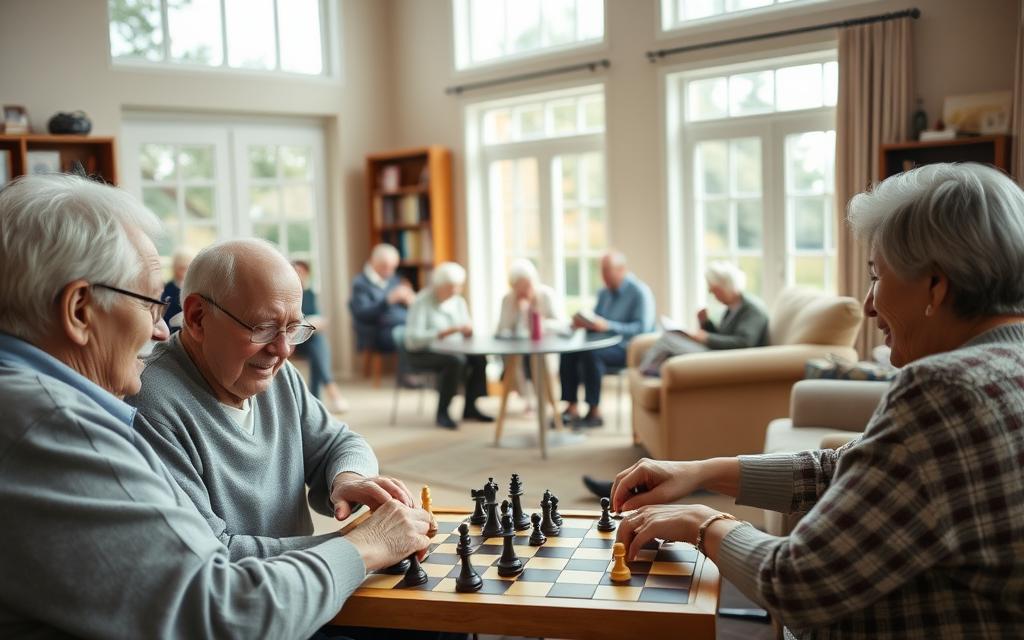
Light Activities Suitable for the Aging Population
Light activities are key for the elderly, helping them stay mobile and happy. Adding these gentle exercises to daily life boosts health and mood. Simple tasks or hobbies help keep older adults active and engaged.
It’s important for them to enjoy these activities. This way, they feel accomplished and connected.
Examples of Light Activities
- Leisurely walking around the neighborhood
- Engaging in household chores like dusting or organizing
- Gentle stretching exercises at home
- Participating in group activities such as dance or singing
- Gardening or light outdoor work
- Playing board games or completing puzzles
Benefits of Incorporating Light Activity
Regular light activities bring many benefits. These include:
| Benefits | Description |
|---|---|
| Improved Cardiovascular Health | Light activities enhance heart health by promoting blood circulation. |
| Reduced Fall Risk | Gentle exercises improve balance and strength, lowering the chance of falls. |
| Elevated Mood | Engaging in activities releases endorphins, boosting mental well-being. |
| Increased Mobility | Regular movement maintains joint flexibility and muscle function. |
| Social Interaction | Group activities foster connections, reducing feelings of loneliness. |
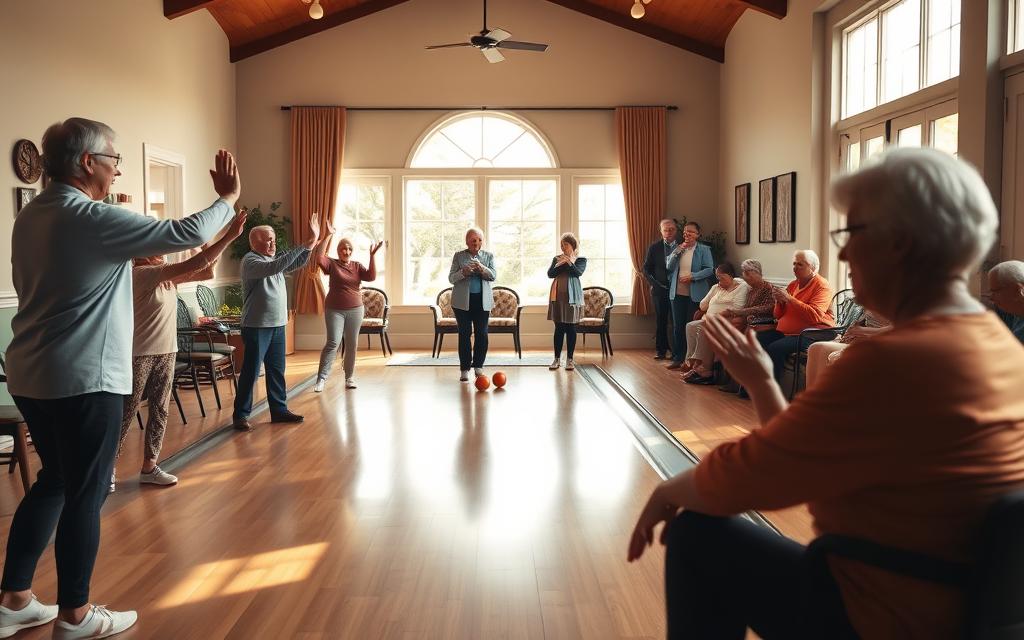
Moderate Intensity Activities to Consider
Staying active is key for seniors. Moderate activities raise your heart rate and breathing without too much tiredness. Knowing what you can do and what’s out there can make you feel better.
How to Gauge Moderate Intensity
To check if an activity is moderate, see if you can talk while doing it. If you can, but it’s a bit hard, it’s good. Try to do at least 150 minutes of this each week. Even a little bit of activity helps a lot.
Popular Moderate Intensity Activities
There are many fun activities that are good for seniors. Here are a few:
- Brisk walking
- Water aerobics
- Dancing
- Gardening
- Tai Chi
These activities are great for staying fit and having fun. They also help you meet people and feel happy. Doing them regularly can make you healthier and happier.
| Activity | Duration (minutes/week) | Benefits |
|---|---|---|
| Brisk Walking | 150 | Improves cardiovascular health |
| Water Aerobics | 150 | Low-impact, joint-friendly |
| Dancing | 150 | Boosts mood and social interaction |
| Gardening | 150 | Enhances mood, provides gentle movement |
| Tai Chi | 150 | Improves balance and flexibility |
Vigorous Intensity Activities for Experienced Elders
Vigorous activities are key for boosting fitness in seniors who are used to being active. Running, swimming laps, or cycling fast are great for improving endurance. These activities help seniors stay healthy and feel better overall.
Only about 20% of adults and teens get enough exercise each week. Older adults should aim for 75 minutes of vigorous activity weekly. This means they should be out of breath quickly when trying to speak.
Older adults should mix vigorous and moderate activities. They should also do muscle-strengthening exercises on at least two days. This helps keep bones strong, improves balance, and lowers fall risks.
Adding vigorous activities to a routine for seniors over 65 needs careful planning. It’s best to talk to a doctor first, to make sure it’s safe. Doing so can greatly improve their quality of life, reducing health risks and boosting mental health.
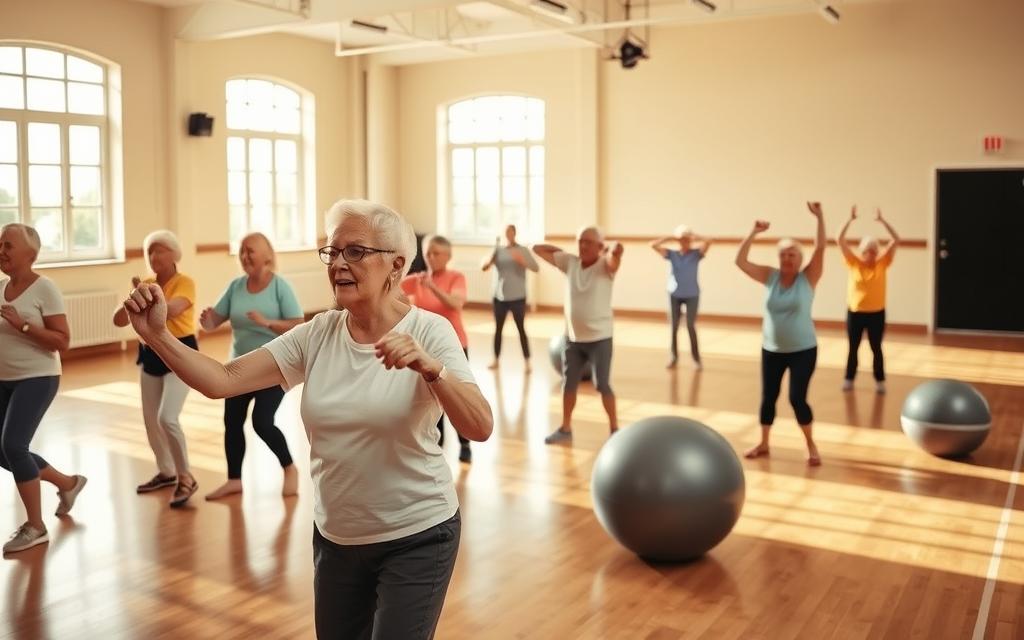
| Activity Type | Example Activities | Recommended Duration |
|---|---|---|
| Vigorous Aerobic | Running, swimming laps, cycling | 75+ minutes/week |
| Muscle-Strengthening | Weight lifting, resistance bands | 2+ days/week |
| Balance Activities | Tai Chi, yoga | 2+ days/week |
The Role of Strength and Balance Exercises
Strength training and balance exercises are key for elderly fitness. They help older adults stay physically healthy and lower fall risks. Regular strength training boosts muscle strength and stability.
Benefits of Strength Training
Strength training is great for the elderly. It offers many benefits:
- It helps keep muscle mass and strength up, fighting off aging’s natural decline.
- It boosts bone density, helping prevent osteoporosis.
- It improves daily activity performance, making them more independent.
- It also reduces symptoms of chronic illnesses like arthritis and diabetes.
Exercises to Enhance Balance
Balance exercises are crucial for staying stable. Certain activities are very helpful:
- Tai Chi: This ancient martial art enhances coordination and promotes relaxation.
- Single-leg stands: Standing on one leg improves balance.
- Heel-to-toe walks: This exercise trains the body to stay stable on a narrow base.
- The sit-to-stand movement: Doing this 10 times, twice a day, strengthens legs.
Doing these exercises often can greatly improve lower limb strength and balance. This boosts confidence in moving around.

Practical Tips for Increasing Physical Activity Levels
Helping the elderly get more active can be very rewarding. It’s all about finding fun ways to do it. Start small and be patient to keep them moving for a long time.
Start Slow and Build Gradually
Older adults should begin with easy steps. Small increases in activity help avoid injuries. A short walk each day can help build up their stamina.
As they get stronger, they can aim for 150 minutes of moderate exercise a week. This goal seems more achievable.
Set Realistic Goals and Monitor Progress
Having clear goals helps keep them motivated. Use a journal or app to track progress. This way, they can see how far they’ve come.
Talking to a doctor or fitness expert is also important. It makes sure the goals are safe and right for them.
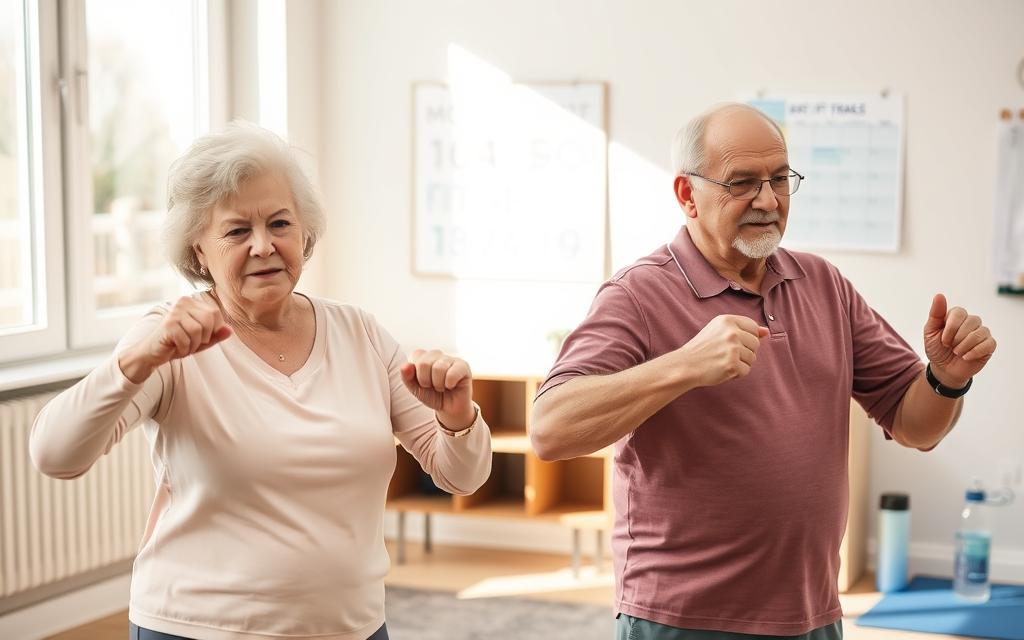
Overcoming Barriers to Physical Activity in Elderly Communities
Many elderly people face barriers to exercise. These can be due to psychological, social, or economic reasons. It’s important to know these obstacles to help seniors stay active and healthy.
By understanding the challenges older adults face, we can find ways to help them. This way, we can make it easier for them to exercise.
Identifying Common Barriers
Some common barriers to exercise include:
- Lack of access to safe places for exercise, affecting about 30% of older adults.
- Concerns about injury or falling, which stop 40% of seniors from exercising.
- Financial issues, with 35% of older adults saying gym memberships or equipment are too expensive.
- Weather conditions, which keep nearly 50% of seniors from exercising outdoors.
- Lack of skill or knowledge in exercising, reported by 25% of older adults, which lowers their confidence.
- Social isolation, where 45% of elderly people feel they lack support from family or friends.
Strategies for Addressing Barriers
To help seniors stay active, we can try several strategies:
- Community programs and classes offer supported environments for older adults. They promote group-based physical activity that motivates participants.
- Encouraging at-home workouts, like online fitness classes, ensures exercise access regardless of weather or mobility issues.
- Creating safe walking paths in neighborhoods provides easy, low-cost exercise options like walking.
- Providing personal trainers or small group sessions can boost confidence and adherence to exercise routines. It ensures proper technique and support.
- Setting achievable goals, such as gardening or playing with grandchildren, can motivate seniors to be active.
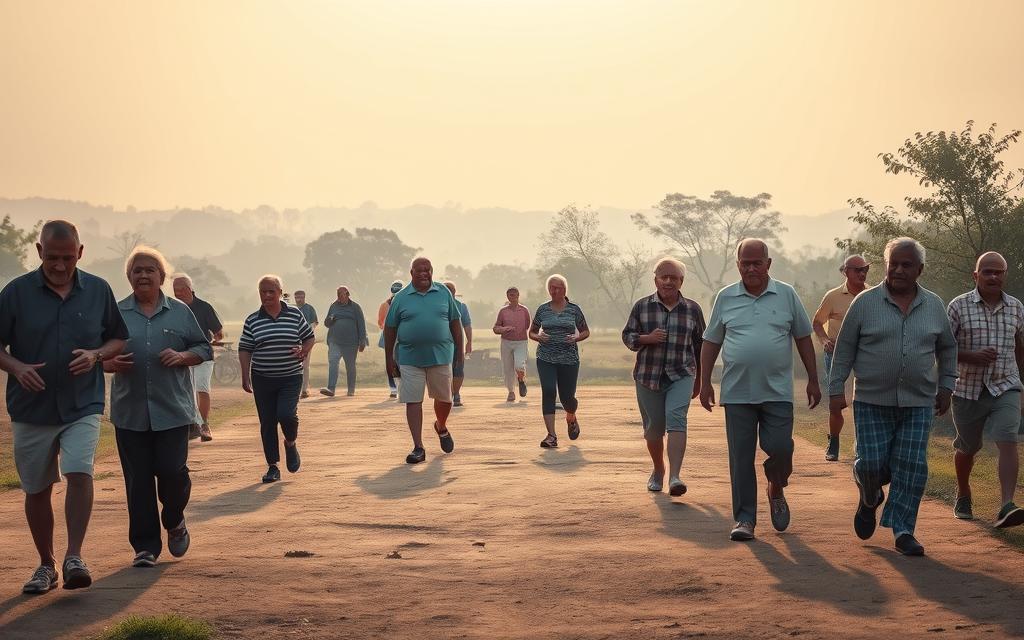
The Importance of Social Support for Physical Activity
Social support is key for older adults to stay active, more so for those over 80. Being part of a group can really boost motivation. Studies show that more social support means more time spent exercising; an extra 11 minutes a week for each unit of support.
Getting seniors involved in community activities helps them stay fit and feel connected. Many seniors struggle to keep up with fitness, but support from friends and family can make a big difference. Activities like classes or walking groups help them stick to their exercise plans.
Also, 57% of older adults meet the World Health Organization’s activity guidelines. This means they do 150 minutes of moderate to vigorous activity each week. Being part of a community can help those who don’t meet these guidelines, making them more likely to exercise regularly.
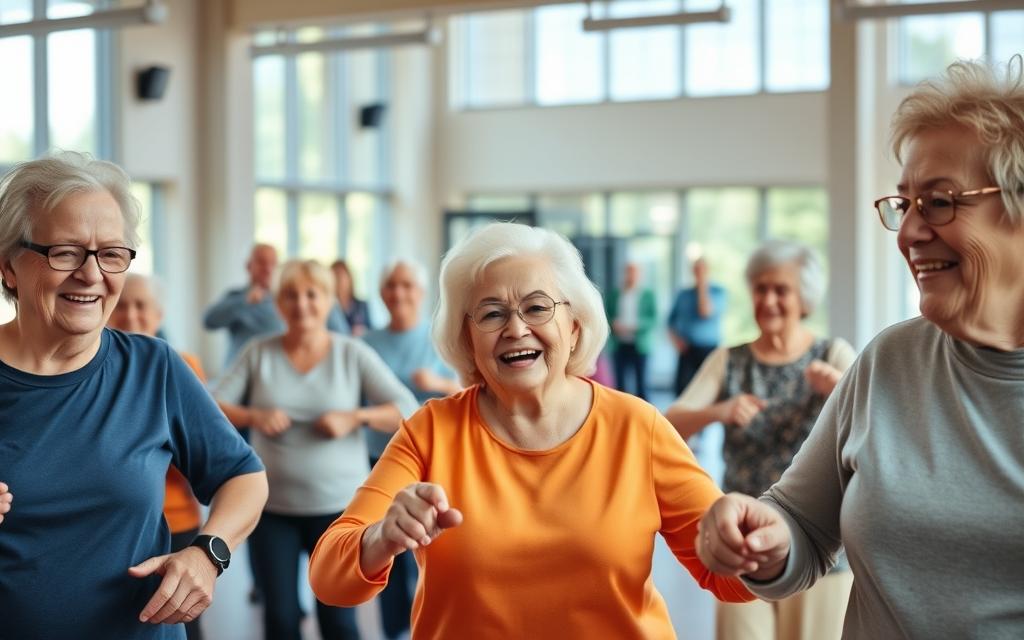
To get the most out of social support, we need to make it easy for seniors to join in. Using local resources and building community ties can help seniors exercise more. This improves their health and overall well-being.
Creating a Safe and Accessible Environment for Seniors
A safe living environment is key for older adults to stay active. Making spaces accessible encourages them to exercise outdoors. It also reduces risks in senior living. It’s important to adapt homes and ensure outdoor areas are safe for activities.
Adapting the Home for Safety
Only 10% of homes are ready for older adults. This shows a big need for changes. Most homes lack key features, making falls more common.
Many falls happen in bedrooms, bathrooms, and stairs. These areas need special attention.
- Ensure doorways and hallways are at least 32 inches wide for wheelchair access.
- Install grab bars in bathrooms to reduce fall risk by up to 50%.
- Use non-slip mats to decrease slipping hazards by about 80%.
- Enhance lighting throughout the home, which can lower fall risk by 40%.
- Incorporate smart home devices to decrease emergency incidents by 20%.
Finding Safe Outdoor Spaces for Activity
Safe outdoor areas are vital for seniors to stay active. Parks and paths encourage exercise and socializing. These are important for health and happiness.
Creating a safe home and offering outdoor activities helps seniors live better. It supports their independence and improves their life quality.
Engaging in Varied Activities to Maintain Interest
Adding different activities to a senior’s day is key for keeping them engaged and fit. These activities prevent boredom and reduce injury risks from doing the same thing over and over. Walking outdoors, for example, is great for the heart and mood, and it’s a chance to meet new people.
Group exercises like chair yoga and tai chi are perfect for seniors who have trouble moving. They make staying active fun and easy. For those who love to think, games and puzzles can help keep their memory sharp.
Helping out in local charity projects gives seniors a chance to make a difference. It also helps them feel connected and gives them a sense of purpose. Gardening is another great activity that boosts mental health and strengthens bonds with family, like grandchildren.
Virtual fitness classes are a great option for seniors who like to work out at home. They keep fitness a priority, even when getting around is hard. Getting discounts on local attractions makes it easier to stay social and keep connections strong.
| Activity Type | Benefits |
|---|---|
| Walking | Improves cardiovascular health and provides social interaction |
| Chair Yoga | Enhances flexibility and provides low-impact exercise |
| Gardening | Promotes mental well-being and creativity |
| Puzzles and Games | Stimulates cognitive functions |
| Volunteering | Boosts self-esteem and fosters emotional connections |
Seniors can stay physically and mentally sharp by trying new things. These activities help them live a happy, active life. They lead to better health and happiness overall.
Choosing the Right Activewear for Comfort and Safety
Choosing the right activewear is key for older adults who want to stay active. It’s all about comfort and safety. The right clothes help them feel good and move easily.
Footwear Essentials for Older Adults
Shoes are very important for stability and support. They should have:
- Good arch support to prevent strain
- Non-slip soles for enhanced traction
- Comfortable fit to accommodate any foot swelling
- Lightweight design to reduce fatigue during extended wear
These features help older adults avoid injuries and feel safe while exercising.
Selecting Clothing That Supports Movement
Choosing the right clothes is very important. Activewear should:
- Moisture-wicking fabrics to keep the body dry
- Breathability to ensure comfort during movement
- UV protection, for outdoor activities
- Temperature regulation to keep the body at a comfortable level
High-waisted leggings and long-sleeved tops are great for support and warmth. They make exercising more comfortable for seniors.
| Activewear Feature | Importance |
|---|---|
| Moisture-Wicking Fabrics | Keeps skin dry and comfortable |
| Non-Slip Footwear | Reduces risk of falls and enhances stability |
| Breathability | Prevents overheating during activity |
| High-Waisted Design | Offers abdominal support during exercise |
The Influence of Technology on Elder Care and Activity
Technology has greatly improved the physical activity of older adults. Online fitness resources make it easy for seniors to find exercise programs that fit their needs. Virtual classes help them stay active and connect with others, which is important since many seniors feel lonely.
More than one in three older adults feel lonely, which is as bad as smoking or obesity for their health. This loneliness can lead to serious health problems.
Exercise apps for seniors offer guidance and motivation. They send reminders to stay active and help with taking medicine. Wearable devices track important health signs like heart rate and blood pressure. This helps seniors stay on top of their health.
Online fitness resources let seniors work out from home, which is great for those with physical limitations. They can join virtual exercise groups, which helps them stay motivated and active.
Voice-activated tech and smart home systems make life easier for seniors. They can control devices with voice commands, making daily tasks simpler. Telehealth services have also become more popular, offering healthcare without the need to travel.
Using technology keeps seniors physically and mentally sharp. Regular internet use can lower the risk of dementia. Technology is key in helping seniors live active and fulfilling lives.
Resources and Programs Available for Elderly Physical Activity
Many resources help older adults stay active and healthy. Community centers and local gyms offer special programs for seniors. Programs like SilverSneakers and YMCA classes are popular, providing a good place to exercise.
Online platforms also help, with videos and tools for tracking fitness. These tools let seniors work out at home. Some top programs include:
| Program Name | Description | Frequency |
|---|---|---|
| Active Choices | Individualized physical activity support focusing on personal goals. | 6 months |
| Active Living Every Day (ALED) | Group-based methods to integrate physical activity into daily life. | Ongoing |
| Geri-Fit® | Resistance strength training focused on muscle strength improvement. | Twice weekly for 45 minutes |
| EnhanceFitness | Includes stretching, flexibility, balance, low-impact aerobics, and strength training. | 1 hour, three times weekly |
| Walk with Ease | Helps develop personalized walking plans for improved mobility. | Ongoing |
The CDC says older adults should do moderate exercise for 30 minutes, five days a week. But, only about a third of Americans over 65 do this. Programs like Tai Chi for Arthritis and Walk with Ease are designed for seniors. They help meet specific needs and improve health and life quality.
Conclusion
It’s key to keep older adults active for their health and happiness. As more people live longer, it’s important to know how to help them stay fit and feel good. Exercise helps them avoid health problems and feel connected to others.
Helping older adults exercise means giving them the right tools and support. We need to make it easy for them to stay active. This way, families and caregivers can help seniors live better, more active lives.
Looking ahead, making physical activity a priority for seniors is crucial. It’s not just about their health today. It’s about giving them a happy, full life. We need to keep studying and working on ways to help them stay healthy and active.
FAQ
Why is physical activity important for elderly individuals over 80?
Physical activity is key for older adults. It lowers disease risk, boosts mobility, and improves mental health. It also helps them stay independent, leading to a better life.
What types of activities are recommended for seniors?
Seniors can enjoy walking, swimming, yoga, and light gardening. These activities are tailored to fit each person’s abilities, making them fun and sustainable.
How much physical activity should older adults aim for weekly?
Older adults should do at least 150 minutes of moderate or 75 minutes of vigorous activity weekly. They should also do muscle-strengthening exercises twice a week.
What are light activities that older adults can incorporate into their routines?
Light activities include doing household chores, walking, and stretching. These are key for better mobility and should be part of daily life.
What constitutes moderate-intensity physical activity for seniors?
Moderate activities raise heart rates and allow for talking. Examples are brisk walking and water aerobics, which also help with socializing.
Are there any vigorous activities suitable for older adults?
Seasoned seniors without health issues might enjoy vigorous activities like running. But, it’s important to check with a doctor first to ensure safety.
How can strength and balance exercises benefit the elderly?
Strength and balance exercises are crucial for preventing falls and boosting independence. They improve muscle stability, coordination, and confidence in moving around.
What barriers might prevent seniors from engaging in physical activity?
Seniors might face barriers like not knowing how, safety worries, or lack of access to places. Knowing these challenges helps find solutions.
How does social support influence physical activity levels in older adults?
Support from friends, family, or groups makes seniors feel included. This boosts their motivation and commitment to staying active.
What safety adaptations can be made in the home for seniors?
Making homes safe includes using non-slip mats, good lighting, and clearing clutter. This reduces fall risks, encouraging more activity.
Why is variety important in physical activity for older adults?
Variety keeps activities interesting and prevents injuries from doing the same thing too much. It keeps seniors engaged all year.
What should older adults consider when choosing activewear?
Good activewear includes supportive shoes and clothes that let you move easily. It should be comfortable, fit well, and keep you dry.
How can technology assist seniors in maintaining physical activity?
Technology like online classes, fitness trackers, and apps can motivate seniors. It offers virtual support and communities for staying active.
What resources and programs are available for promoting physical activity among the elderly?
Many resources are out there, like community centers, gyms, and programs like SilverSneakers and YMCA classes. There are also online platforms for support.
